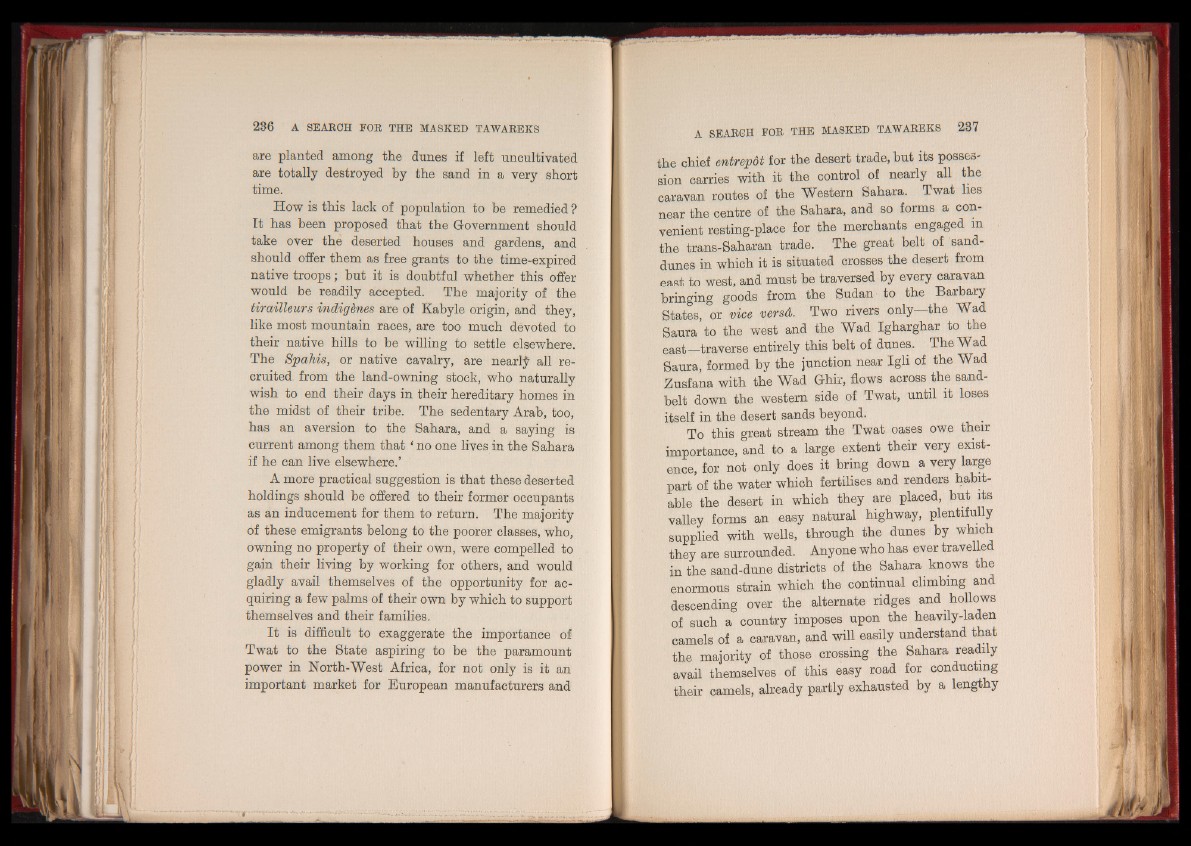
are planted among the dunes if left uncultivated
are totally destroyed by the sand in a very short
time.
How is this lack of population to be remedied ?
It has been proposed that the Government should
take over the deserted houses and gardens, and
should offer them as free grants to the time-expired
native troops ; hut it is doubtful whether this offer
would be readily accepted. The majority of the
tirailleurs indigènes are of Kabyle origin, and they,
like most mountain races, are too much devoted to
their native hills to be willing to settle elsewhere.
The Spahis, or native cavalry, are nearlÿ all recruited
from the land-owning stock, who naturally
wish to end their days in their hereditary homes in
the midst of their tribe. The sedentary Arab, too,
has an aversion to the Sahara, and a saying is
current among them that 4 no one lives in the Sahara
if he can live elsewhere.’
A more practical suggestion is that these deserted
holdings should be offered to their former occupants
as an inducement for them to return. The majority
of these emigrants belong to the poorer classes, who,
owning no property of their own, were compelled to
gain their living by working for others, and would
gladly avail themselves of the opportunity for acquiring
a few palms of their own by which to support
themselves and their families.
It is difficult to exaggerate the importance of
Twat to the State aspiring to be the paramount
power in North-West Africa, for not only is it an
important market for European manufacturers and
the chief entrepôt for the desert trade, but its possession
carries with it the control of nearly all the
caravan routes of the Western Sahara. Twat lies
near the centre of the Sahara, and so forms a convenient
resting-place for the merchants engaged in
the trans-Saharan trade. The great belt of sand-
dunes in which it is situated crosses the desert from
east to west, and must be traversed by every caravan
bringing goods from the Sudan to the Barbary
States, or vice versâ. Two rivers only the Wad
Saura to the west and the Wad Igharghar to the
east—traverse entirely this belt of dunes. The Wad
Saura, formed by the junction near Igli of the Wad
Zusfana with the Wad Ghir, flows across the sand-
belt down the western side of Twat, until it loses
itself in the desert sands beyond.
To this great stream the Twat oases owe their
importance, and to a large extent their very exist
ence, for not only does it bring down a very large
part of the water which fertilises and renders habitable
the desert in which they are placed, but its
valley forms an easy natural highway, plentifully
supplied with wells, through the dunes by which
they are surrounded. Anyone who has ever travelled
in the sand-dune districts of the Sahara knows the
enormous strain which the continual climbing and
descending over the alternate ridges and hollows
of such a country imposes upon the heavily-laden
camels of a caravan, and will easily understand that
the majority of those crossing the Sahara readily
avail themselves of this easy road for conducting
their camels, already partly exhausted by a lengthy